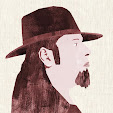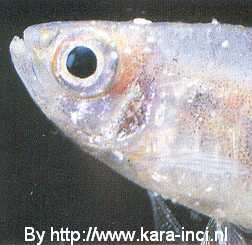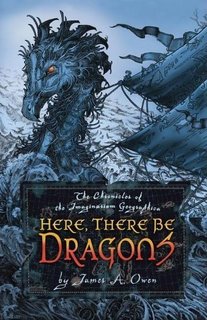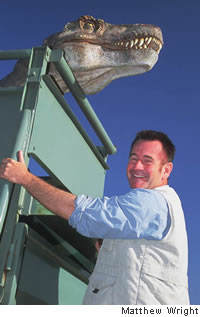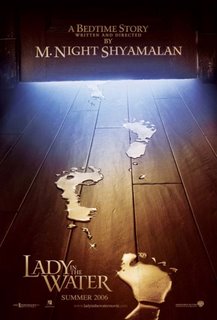 Ja, ja, ik heb de mini-serie Frank Herberts Dune eindelijk uitgekeken deze week.
Ja, ja, ik heb de mini-serie Frank Herberts Dune eindelijk uitgekeken deze week.Al toen ik ervan hoorde in 2000 wilde ik deze serie zien. Ik had de hele serie boeken gelezen en het eerste daarvan (Dune) stond nog vers in mijn geheugen. Zonder kabeltelevisie was de kans op het zien ervan echter vrij klein. Nu heb ik hem op DVD en ik heb de tweede serie al geleend van een vriend van me. Ik kan er niet op wachten die te gaan kijken! Misschien vanavond.
Maar goed, eerst de eerste serie. Het was een feest van herkenning terwijl allerlei personen en gebeurtenissen uit het boek op het scherm kwamen. De ingewikkelde verhoudingen tussen de verschillende edele huizen, de Bene Gesserit (een vrouwelijke orde gericht op het 'kweken' met mensen) en het ruimtegilde waren goed weergegeven, duidelijker dan in de jaren '80 film in elk geval.
Het huis Atreides krijgt de controle over de woestijnplaneet Arrakis. Dit is de enige plaats in het heelal met 'Spice', het goedje dat snelle ruimtereizen mogelijk maakt, kortom waar het hele keizerrijk van afhankelijk is. Natuurlijk zijn er kapers op de kust. De vorige bezetters van Arrakis, het huis Harkonnen, blijkt een lid van de Atreides huishouding te hebben aangezet tot een gruwelijk verraad. Alleen Jessica, de concubine van graaf Leto, en zijn zoon Paul ontsnappen. Ze storten neer in de woestijn en maken daar kennis met de Fremen: een volk dat leeft in de woestijn, met allerlei gebruiken die draaien om het behoud van water. Jessica beschikt vanwege haar training door de Bene Gesserit over schijnbaar bovennatuurlijke eigenschappen, en weet zo een plek in de samenleving van de Fremen te veroveren. Paul neemt de naam aan van 'Muad d'ib' en krijgt een leidinggevende positie. Hij wordt geplaagd door toekomstvisioenen, die in heftigheid toenemen. Als hij Arrakis wil bevrijden van de tirannie van de Harkonnen moet hij zijn bestemming omarmen...
In de traditie van deze blog eerst een paar dingen die ik minder geslaagd vond. Het was duidelijk dat het budget van deze eerste serie niet erg hoog was. Dat het er desondanks zo episch uitziet is bewonderenswaardig. Maar voor iemand die SF-films uit Hollywood gewend is, is het even wennen aan geschilderde achtergronden en duidelijk neppe gevechten. Ook de computereffecten lijken soms net niet af (vooral een soort van woestijnmuis was niet echt overtuigend). Mijn andere negatieve commentaar betreft de karakterisatie van sommige bijfiguren. In het boek waren alle bijfiguren geloofwaardig, maar bovenal maakten ze een blijvende indruk: karakters als Duncan Idaho, Gurney Halleck en Stilgar. In de serie merkte ik dat ik niet zo aan ze hechtte als toen ik het boek las. Vooral Duncan Idaho, die ook in de latere boeken voorkomt, kwam er bekaaid af.
De rest van de hoofdpersonen waren echter trouw aan hun versies uit de boeken. Graaf Leto, gespeeld door William Hurt uit de film Lost in Space, is een sympathiek familiehoofd. De acteur die Paul speelt toont zijn naiviteit in het begin en zijn steeds fanatiekere houding als hij de rol aanneemt van de Mahdi, de beloofde bevrijder van de Fremen. En de ecoloog dr. Kynes vond ik zelfs beter dan in het boek.
De serie heeft, net als het boek, duidelijke religieuze ondertonen. De Fremen verwachten een messias, die hen zal bevrijden en van Arrakis een groene tuin zal maken. Paul kan de toekomst zien, maar als hij zich opwerpt als messias, zal hij dan een gruwelijke heilige oorlog ontketenen? Zal hij een goede leider blijken of een tiran worden? Maar als hij niets doet loopt de samenleving ook op een einde... De strijd op de achtergrond is tussen vrije keuze en manipulatie. De Bene Gesserit (en de Harkonnens) zijn er meesters in dingen van anderen gedaan te krijgen. De eerste door subtiele beïnvloeding, de tweede door bedreiging en marteling. Paul onttrekt zich echter aan hun controle, ook al is hij de 'Kwizatz Haderach', het doel van het programma van de Bene Gesserit. Hij wil zijn eigen bestemming bepalen. Maar wat als dat tegelijk zijn lot blijkt te zijn?
De serie geeft geen antwoorden op al deze vragen, maar ze zijn interessant genoeg om over na te denken.
Wij dreigen ook van alle kanten gemanipuleerd te worden: door onze ouders, onze overheid, onze cultuur. Iedereen wil iets van ons: onze tijd, ons geld, onze overtuiging. En we denken dat God ons ook wil manipuleren. Er zijn ook talloze voorbeelden van manipulerende godsdiensten en kerken, daarvoor hoeven we alleen maar het nieuws aan te zetten. Als we ons bewust worden van al deze valstrikken, deze netten waarin we vastzitten, gaan we verlangen naar vrijheid. En de bijbel zegt dat we deze vrijheid vinden als we ons aan God overgeven. Dat lijkt paradoxaal: moet je dan niet allerlei dingen van God? Het antwoord is kort: nee. Gods doel is ons helemaal vrij te maken. "Om vrij te zijn heeft christus u vrijgemaakt, laat u daarom niet weer een slavenjuk opleggen" (Galaten 5). Vrij van de wet, vrij van elke verplichting, maar ook vrij van elke zondige beïnvloeding. God manipuleert niet. Hij laat ons vrij om voor Hem te kiezen of Hem af te wijzen. En als we voor Hem kiezen hoeven we niet te voldoen aan allerlei regeltjes of wetten. Hij werkt zelf in ons, geeft ons een nieuw leven. Hij herstelt ons naar het beeld van God, zoals we oorspronkelijk bedoeld waren. We weerspiegelen God in ons denken, onze emoties, onze wil. Deze nieuwe mens wil niet anders dan God en andere mensen liefhebben. Daarom noemt de bijbel het gebod "Heb uw naaste lief als uzelf" ook de "wet van de vrijheid." De herstelde persoon die we worden, die nieuwe Johan, Kaas, Piet of Katrien, is compleet vernieuwd met de diepe verlangens die God in ons hart geschapen heeft. Dus zal het uiteindelijk zo zijn, dat als we doen wat we ten diepste willen, we voldoen aan de bestemming van God op ons leven. De kerkvader Augustinus verwoordde het zo: "Heb God lief en doe wat u wilt."We vervullen ons lot, niet in manipulatie, maar in vrijheid. Ik begrijp dat het ingewikkeld is, en paradoxen zijn altijd moeilijk in een paar regels uit te leggen, maar het is volgens mij wel heel belangrijk.
Er zat nog meer in de serie wat mijn verlangen aansprak. Ten eerste het ontwerp van de ruimteschepen en kostuums. Het wijkt behoorlijk af van de standaard SF-vormgeving, met veel Japanse en bijna middel-eeuwse elementen. En erg veel soorten hoeden.
Ten tweede het hele idee van een beschaving aangepast aan het leven in de woestijn. Met speciale pakken recyclen ze zelf het zweet. Voor iemand op de grond spugen staat gelijk aan een waardig eerbetoon en huilen is 'Water voor iemand spillen'. In het boek is de samenleving van de Fremen, met al hun gebruiken en rituelen, nog veel gedetailleerder beschreven, maar de film gaf al een aardige indruk.
En dan zijn er de wormen: honderden meters lange wormen onder het zand van Arrakis, groot genoeg om een hele 'Spice'-mijninstallatie te verorberen. Als ze boven het zand uitrijzen vormen ze een ontzagwekkend gezicht. Helaas waren ook hier de special effects niet helemaal overtuigend, maar toch was het mooi ze uitgebeeld te zien. In de tweede serie schijnen ze nog indrukwekkender te zijn. Ik ben benieuwd.
Voor de geeks onder mijn lezers: een vergelijking tussen Star Wars en Duin. Het blijkt dat George Lucas toch behoorlijk is beïnvloed door het boek.
[Well, I've finally watched the miniseries Frank Herberts Dune this week.
Since I learned of this series in 2000 I hoped to see it once. I read the whole series of novels and the first (Dune) was still clear in my mind. But without cabletelevision the chance of seeing it was really small. Now I own the series on DVD and I have already borrowed the second. I can hardly wait to watch it. Maybe I'll start this evening.
Back to the first series. It was a feast of recognition while all kinds of persons and incidents from the book passed on the screen. The complicated relations between the noble houses, the Bene Gesserit (a female order aiming at improving bloodlines) and the spacinguild were well realised, more clearly than in the '80's movie I thought.
House Atreides is sent to the desertworld Arrakis. This is the only place in the galaxy with 'Spice', the stuff that makes fast travel through space possible and is thus essential for the continuation of the galactic empire. Ofcourse there are others interested in Arrakis. The former occupants of the planet, House Harkonnen, turns out to have bought a member of the Atreides household and a disastrous betrayal takes place. Only Jessica, count Leto's concubine, and his son Paul, manage to get away. Crashed in the desert they meet the Fremen: a people living in the depths of the desert, with all kinds of rituals about the conservation of water. Because of her Bene Gesserit training Jessica has seemingly supernatural powers and she can carve a niche for her in the Fremen society. Paul takes on the name 'Muad d'ib' and finds a place as a leader. He is plagued by visions of the future, growing in intensity. If he wants to free Arrakis of the Harkonnen tiranny he will have to embrace his destiny...
In the tradition of this blog first a couple of things I liked less. It was clear the budget of this first series wasn't very high. It's a wonder scenes look as epic as they do, though. But for someone used to hollywoodmovies it's jarring to be confronted with painted background and clearly faked fights. The computer effects too sometimes are not quite finished (especially a kind of mouse was not convincing at all). My other more negative comment is about the characterisation of some minor characters. In the book all characters were believable and made a lasting impression: people like Ducan Idaho, Gurney Halleck and Stilgar. In the series they didn't stand out to me. Especially Duncan Idaho was a cipher.
The other protagonists were true to their versions in the books. Count Leto, played by William Hurt from the movie Lost in Space, is a sympathetic pater familias. The actor who plays Paul shows his naivity at the start and his growing fanaticism as he takes on the role of the Mahdi, the promised rescuer of the Fremen. And ecologist dr. Kynes was better than in the book.
Just like the book the series has clear religious underpinnings. The Fremen expect a messiah who shall free then and turn Arrakis into a green garden. Paul can see the future, but if he proclaims himself the messiah, will he ignite a religious war? Will he turn out to be a good leader, or will he become a tirant himself? But if he doesn't do anything society is doomed as well... In the background a battle rages between free choice and manipulation. The Bene Gesserit and the Harkonnen are masters in bending others to do their will. The first by subtle guidance, the second by intimidation and torture. Paul can't be controlled, even though he is the 'Kwizatz Haderach', the goal of the Bene Gesserit's breeding program. He wants to choose his own destiny. But what if that turns out to be his fate after all?
The series doesn't answer all these questions, but they are interesting to think about none the less.
We too are manipulated from all sides: by our parents, our governments, our culture. Everybody wants to get something from us: our time, our money, our conviction. And we think God wants to manipulate us too. There are lots of examples of manipulating religions and churches, we only have to watch the news to see that. If we become conscious of all these traps and nets by which we are bound, we start to desire freedom. And the bible says we will find this freedom only when we give ourselves over to God. That seems a paradoxal situation: doesn't God command us to do lots of things? The answer in short is: No. Gods purpose is to make us free. "To be free Christ has made you free, don't let yourself be made a slave again" (Galatians 5) Free from the law, free from every obligation, but also free from every influence of sin. God does not manipulate. He gives us freedom to choose to believe in Him, or to turn away from Him. And if we choose to follow Him, we don't have to obey all kinds of rules or regulations. He himself changes us, gives us a new life. He restores us to the image of God, the way we were meant to be. We will mirror God in our thoughts, our emotions, our will. This new man wants no other thing than to love God and other people. That's why the commandment "love your neighbour as yourself" in the bible is called "the law of freedom". The restored person we become, the new Johan, Jack, Paul or Rose is totally renewed, complete with the deep desires God has created in our hearts. Thus in the end when we do what we deeply want to do we will fulfill the destiny of our lives. Saint Augustin already said: "Love God and do what you want". We fulfill our destiny, not by manipulation, but in freedom. I understand this is complex and paradoxes are hard to explain in just a few lines, but I think it is important none the less.
There was more in this series that spoke to my desire: firstly the design of spaceships and costumes. It differed from the usual SF-design, with lots of Japanese and faux-middle ages elements. And many kinds of hats.
Secondly the idea of a society in all aspects adapted to life in the desert. With special suits they even recycle sweat. To spit on the ground is to bestow honour, and to cry is to 'spill water before someone'. The society is more cleary drawn in the book, with all the customs and rituals, but the movie gave a good impression.
Then there are the sandworms: hundreds of meters long and living beneath the sands of Arrakis, large enough to swallow a Spice mining facility. Rising above the sand they are an awe-inspiring sight. Sadly the special effects of the worms were not fully convincing, but it was great to see them on the screen none the less. In the second series the should be even more impressive. I look forward to it.
For every geek among my public: a comparison between Star Wars and Duin. It turns out George Lucas has been influenced by the book for a fair bit.]
